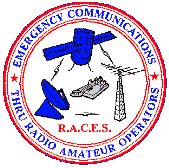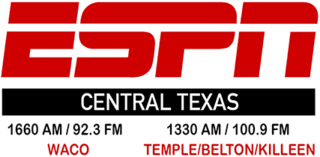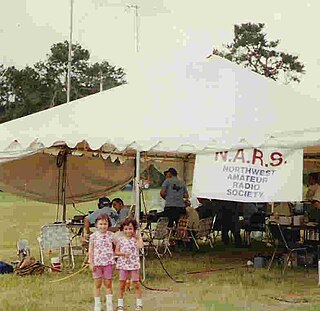The American Radio Relay League (ARRL) is the largest membership association of amateur radio enthusiasts in the United States. ARRL is a non-profit organization and was co-founded on April 6, 1914, by Hiram Percy Maxim and Clarence D. Tuska of Hartford, Connecticut. The ARRL represents the interests of amateur radio operators before federal regulatory bodies, provides technical advice and assistance to amateur radio enthusiasts, supports a number of educational programs and sponsors emergency communications service throughout the country. The ARRL has approximately 161,000 members. In addition to members in the US, the organization claims over 7,000 members in other countries. The ARRL publishes many books and a monthly membership journal called QST.

In the United States and Canada, the Amateur Radio Emergency Service (ARES) is a corps of trained amateur radio operator volunteers organized to assist in public service and emergency communications. It is organized and sponsored by the American Radio Relay League and the Radio Amateurs of Canada.
The amateur auxiliary was an American amateur radio organization operated by the American Radio Relay League between 1994 and 2019 that was authorized by and worked in conjunction with the Federal Communications Commission (FCC). The Auxiliary consisted of official observer volunteer amateur radio operators who monitored amateur radio service frequencies. This was one way in which the FCC encouraged amateur radio operators in the United States to self-police.

The Radio Amateur Civil Emergency Service (RACES) is an emergency radio service authorized in Part 97.407 of the Federal Communications Commission (FCC) rules and regulations governing amateur radio in the United States.
The 1.25-meter, 220 MHz or 222 MHz band is a portion of the VHF radio spectrum internationally allocated for amateur radio use on a primary basis in ITU Region 2, and it comprises frequencies from 220 MHz to 225 MHz. In the United States and Canada, the band is available on a primary basis from 222 to 225 MHz, with the addition of 219 to 220 MHz on a limited, secondary basis. It is not available for use in ITU Region 1 or ITU Region 3. The license privileges of amateur radio operators include the use of frequencies within this band, which is primarily used for local communications.

Amateur radio international reciprocal operating agreements permit amateur radio operators (hams) from one country to operate a station whilst traveling in another without the need to obtain additional licenses or permits.

In times of crisis and natural disasters, amateur radio is often used as a means of emergency communication when wireline, cell phones and other conventional means of communications fail.

In the United States, amateur radio licensing is governed by the Federal Communications Commission (FCC). Licenses to operate amateur stations for personal use are granted to individuals of any age once they demonstrate an understanding of both pertinent FCC regulations and knowledge of radio station operation and safety considerations. There is no minimum age for licensing; applicants as young as five years old have passed examinations and were granted licenses.
Winlink, or formally, Winlink Global Radio Email, also known as the Winlink 2000 Network, is a worldwide radio messaging system that uses amateur-band radio frequencies and government frequencies to provide radio interconnection services that include email with attachments, position reporting, weather bulletins, emergency and relief communications, and message relay. The system is built and administered by volunteers and is financially supported by the Amateur Radio Safety Foundation.
The Shuttle Amateur Radio Experiment (SAREX), later called the Space Amateur Radio Experiment, was a program that promoted and supported the use of amateur ("ham") radio by astronauts in low Earth orbit aboard the United States Space Shuttle to communicate with other amateur radio stations around the world. It was superseded by the Amateur Radio on the International Space Station (ARISS) program. SAREX was sponsored by NASA, AMSAT, and the ARRL.
The War Emergency Radio Service (WERS) was a civil defense service in the United States from 1942 to 1945. It was replaced by the current Radio Amateur Civil Emergency Service (RACES) system.
The 2200-meter or 136 kHz band is the lowest frequency band in which amateur radio operators are licensed to transmit. It was formally allocated to amateurs at the 2007 World Radiocommunication Conference (WRC-07). The band is available on a secondary basis in all ITU regions with the limitation that amateur stations have maximum radiated power of 1 watt effective isotropic radiated power.

WISE is a radio station broadcasting a sports format. Licensed to Asheville, North Carolina, United States, it serves the Asheville area. The station is owned by Saga Communications, and operates as part of its Asheville Radio Group.
In the U.S., Part 97 is the section of Federal Communications Commission (FCC) rules and regulations that pertains to amateur radio and the conduct of amateur radio operators. It is a part of Title 47 of the Code of Federal Regulations (CFR).

KHKR was an American radio station broadcasting a sports format. Licensed to Washington, Utah, United States, the station was owned by Townsquare Media.

KRZI is a radio station, paired with an FM relay translator, broadcasting a sports format. Both facilities are licensed to Waco, Texas, United States, and serve the Waco area. KRZI is fully simulcast on sister station 1330 KTON Cameron, extending ESPN Central Texas's coverage area into Temple, Killeen, Belton, and Fort Hood.
The 13 centimeter, 2.3 GHz or 2.4 GHz band is a portion of the UHF (microwave) radio spectrum internationally allocated to amateur radio and amateur satellite use on a secondary basis. The amateur radio band is between 2300 MHz and 2450 MHz, and thereby inside the S-band. The amateur satellite band is between 2400 MHz and 2450 MHz, and its use by satellite operations is on a non-interference basis to other radio users. The license privileges of amateur radio operators include the use of frequencies and a wide variety of modes within these ranges for telecommunication. The allocations are the same in all three ITU Regions.

Amateur radio, also known as ham radio, is the use of the radio frequency spectrum for purposes of non-commercial exchange of messages, wireless experimentation, self-training, private recreation, radiosport, contesting, and emergency communications. The term "amateur" is used to specify "a duly authorized person interested in radioelectric practice with a purely personal aim and without pecuniary interest" ; and to differentiate it from commercial broadcasting, public safety, or professional two-way radio services.

The Northwest Amateur Radio Society (NARS) was established in 1985 and serves the suburban FM 1960 area in Northwest Houston, Texas under the vanity call sign W5NC, an extra-class license issued by the United States Federal Communications Commission (FCC).










